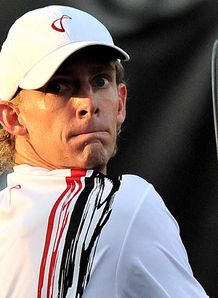 Wikipedia is an amazing resource for tennis. Whoever updates information about tournaments (and there are probably several people) do it lightning quick. Results are often posted in Wikipedia minutes after each round is complete.
Wikipedia is an amazing resource for tennis. Whoever updates information about tournaments (and there are probably several people) do it lightning quick. Results are often posted in Wikipedia minutes after each round is complete.
If you ever scan back to the mid 1980s and check the roster for the US Open, you’ll see that up to 1/3 of the participants are Americans. In the good old days of tennis, there were really only a handful of countries producing top-flight players. The US and Australia were two such countries. However, you could even stretch this number to about 6-7 countries and find 90% of the top 100 players. Now, you’d be lucky to find 15 players, barely above 10%, Americans in the main draw, and that’s even with wildcards that generally favor the home country.
This includes those that are currently solidly entrenched: Roddick, Isner, Querrey, and Fish. The rest hover around 100 or below. The only other player currently in the top 100 is Ryan Sweeting, but players like Michael Russell, Robby Ginepri, Taylor Dent, Bobby Reynolds, and James Blake have been in the top 100 and sometimes much higher.
The rest of the world has caught up. This should be one reason that, as great an accomplishment as Laver’s double Grand Slam was, it should be considered in the light of a small number of countries that had world-class players. Of course, money has created incentives for countries to participate.
There is another interesting trend. Although most popular American college sports still recruit their players from the US, one sport–tennis, has found itself recruiting players outside the US. Players that don’t have the promise of a Novak Djokovic or Andy Murray sometimes find themselves recruited by US colleges to play college tennis. Indeed, generally half the participants in both the men and women’s Division 1 national championships are made up of players born outside the US.
This week, there are three events being played. One in Chile, part of the early clear clay season that works its way through Latin America, one in Croatia played indoors, and one in South Africa.
The record will show that the finalists came from South Africa and India, but the two were products of the US college tennis system. In particular, Kevin Anderson, of South Africa, played for the University of Illinois, and Somdev Devvarman played for the University of Virginia.
A few years ago, Devvarman was working through the qualies at Washington DC, perhaps the nearest tournament to UVA, Devvarman’s alma mater. Despite his Indian heritage, the tournament wasn’t exactly swamped with Indian fans who might have heard of him if they were paying attention. Indians would have likely heard of Mahesh Bhupathi or Leander Paes or Sania Mirza. The UVA fans, who recall Devvarman’s number 1 status, including 2 NCAA titles and one runner-up, were more likely to attend to support their man.
Since both men have joined the tour, Anderson has been the somewhat more successful of the two. It goes to show that height and a big serve is a much quicker route to high rankings than speed. Witness, 6’10” John Isner, 6’6″ Sam Querrey, and of course, players like Marin Cilic, Juan Martin del Potro, Tomas Berdych–all tall players that have used their height and power to vault to the top of the ranks.
Anderson doesn’t have nearly the big game of Querrey or Isner, at least off the ground. He’s probably a touch quicker than Isner, despite being comparable heights.
Both Anderson and Devvarman have reached finals. Kevin Anderson reached the finals of the Tennis Channel Open in Las Vegas in 2008 losing to Sam Querrey. Querrey himself had been knocking on the door of a tournament. He reached the semifinals of Delray Beach only to lose to up-and-comer, Japanese player, Kei Nishikori. Querrey was seriously contemplating college tennis, but decided to go pro and had success, at least, after a while, and never looked back.
Somdev Devvarman reached the finals of his hometown tournament, Chennai, back in 2009, when he lost to Marin Cilic in the finals.
So this tournament, in Johannesburg, South Africa, was going to crown one of the two players with their first ATP title (the ATP tour only counts tournaments at the ATP 250 level or higher, so Challengers and below aren’t part of your official title count).
This must have felt like a college match. Devvarman would take the first set 6-4, but Anderson would take sets 2 and 3 rather handily, 6-3, and 6-2.
Although this is the kind of match that most of the tennis world doesn’t care about, primarily because neither player is in the top ten, it’s a match both finalists care about. This is the life of a journeyman pro, the kind of player that is likely never to reach the quarterfinals of a Slam (or only do it once), and yet stay reasonably productive on tour for 5 to 10 years playing the sport they love.
Ivan Dodig, of Croatia, and the one player that took a set off of Djokovic in Melbourne, won his first ATP title over the higher ranked Michael Berrer of Germany at the Zagreb Indoors final in Croatia.
The finals of the event in Santiago, Chile between Tommy Robredo and Santiago Giraldo (of Colombia) is in a tiebreak now.



![[Stockholm] Dimitrov wins first ATP title with 3-set victory over Ferrer](https://www.essentialtennis.com/wp-content/uploads/2013/10/20131021grigor-500x383.jpg)
![[Metz/St. Petersburg] Simon and Gulbis are champions!](https://www.essentialtennis.com/wp-content/uploads/2013/09/20130922gulbis-500x383.jpg)

